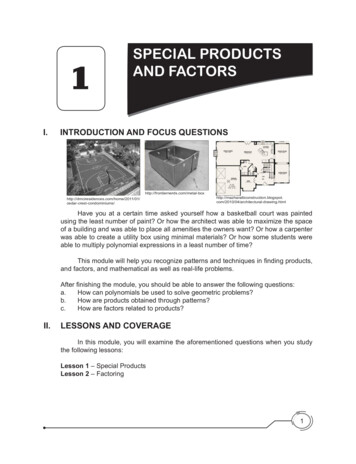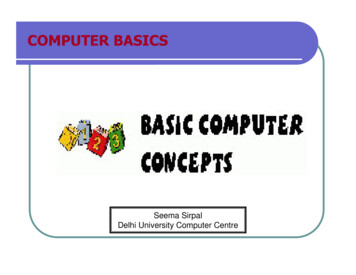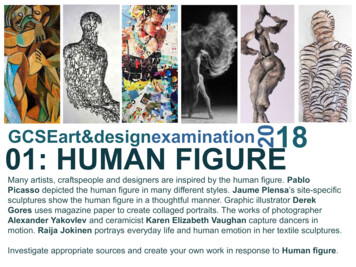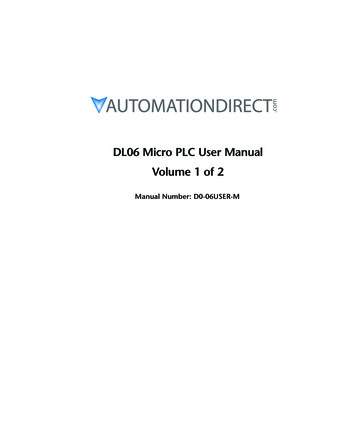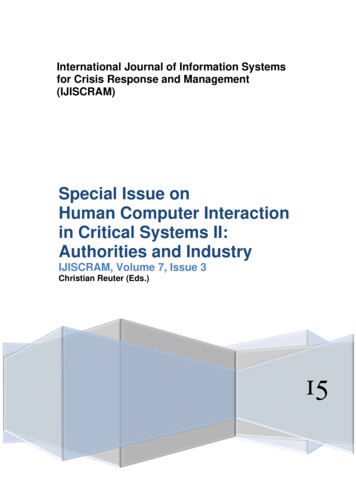
Transcription
International Journal of Information Systemsfor Crisis Response and Management(IJISCRAM)Special Issue onHuman Computer Interactionin Critical Systems II:Authorities and IndustryIJISCRAM, Volume 7, Issue 3Christian Reuter (Eds.)15
International Journal of Information Systems for Crisis Response and Management, 7(3), 2015Christian Reuter (Eds.): Special Issue on Human Computer Interaction in Critical Systems II: Authorities and IndustryiTABLE OF CONTENTSChristian ReuterEDITORIALHenrik Berndt, Tilo Mentler and Michael HerczegOPTICAL HEAD-MOUNTED DISPLAYS IN MASS CASUALTY INCIDENTSJohannes Sautter, Lars Böspflug, Matthias Max, Denis Havlik, Marc Erlich, Kalev Rannatand Wolf EngelbachSIMULATION AND ANALYSIS OF MASS CASUALTY MISSION TACTICS CONTEXT OF USE, INTERACTION CONCEPT, IMPLEMENTATION ANDEVALUATIONKristian Rother, Inga Karl and Simon NestlerTOWARDS VIRTUAL REALITY CRISIS SIMULATION AS A TOOL FORUSABILITY TESTING OF CRISIS RELATED INTERACTIVE SYSTEMSThomas Ludwig, Christoph Kotthaus and Volkmar PipekSHOULD I TRY TURNING IT OFF AND ON AGAIN? OUTLINING HCICHALLENGES FOR CYBER-PHYSICAL PRODUCTION SYSTEMSChristian ReuterTOWARDS EFFICIENT SECURITY: BUSINESS CONTINUITY MANAGEMENT INSMALL AND MEDIUM ENTERPRISES
International Journal of Information Systems for Crisis Response and Management, 7(3), 2015Christian Reuter (Eds.): Special Issue on Human Computer Interaction in Critical Systems II: Authorities and IndustryiiGUEST EDITORIAL PREFACESpecial Issue on HumanComputer Interaction inCritical Systems II:Authorities and IndustryChristian Reuter, University of Siegen, GermanyABSTRACTHuman computer interaction in security and time-critical systems is an interdisciplinarychallenge at the seams of human factors, engineering, information systems and computerscience. Application fields include control systems, critical infrastructures, vehicle and trafficmanagement, production technology, business continuity management, medical technology,crisis management and civil protection. Nowadays in many areas mobile and ubiquitouscomputing as well as social media and collaborative technologies also plays an importantrole. The specific challenges require the discussion and development of new methods andapproaches in order to design information systems. These are going to be addressed in thisspecial issue with a particular focus on technologies for critical practices for authorities andindustry.1EDITORIALAuthorities as well as industry are confronted with many critical practices, they have to dealwith. This special issue tries to address these. It is based on the 2015 workshop on “HumanComputer Interaction and Social Computing in Critical Systems” (Reuter et al., 2015),however also other articles have been considered for submission. Fortunately we received alarge number of submissions which have been reviewed by at least two independent expertsas well as by the guest editor. After up to two rounds of major and minor revisions thefollowing five articles will be presented in this issue:Henrik Berndt, Tilo Mentler and Michael Herczeg (Institute for Multimedia and InteractiveSystems, University of Luebeck) address in their article “Optical Head-Mounted Displays inMass Casualty Incidents” the research questions, whether optical head-mounted displayscould support members of emergency medical services and civil protection units inchallenging medical crises and how human-computer interaction has to be designed with
International Journal of Information Systems for Crisis Response and Management, 7(3), 2015Christian Reuter (Eds.): Special Issue on Human Computer Interaction in Critical Systems II: Authorities and Industryiiirespect to the time- and safety-critical context of use. The human-centered design andevaluation of applications for determining the priority of patients' treatments (triage) and foridentifying hazardous materials with the aid of Google Glass are described. Results indicatethat optical head-mounted displays are a promising technological approach but designing safeand efficient human-computer interaction for wearable systems augmenting reality remains amajor challenge.Johannes Sautter (Fraunhofer IAO), Denis Havlik (Austrian Institute of Technology AIT),Lars Böspflug (Fraunhofer IAO), Matthias Max (German Red Cross), Kalev Rannat (TallinnTechnical University), Marc Erlich (Artelia Group) and Wolf Engelbach (Fraunhofer IAO)describe in their paper “Simulation and Analysis of Mass Casualty Mission Tactics” aninteraction concept allowing a simulation-based analysis of mass casualty mission tactics toleading personnel of emergency medical services. Addressing the needs of the medical civilprotection domain, beside the interaction concept they describe large-scale emergencyscenarios, the context of use and a performed Think-Aloud evaluation.Kristian Rother, Inga Karl and Simon Nestler (Hochschule Hamm-Lippstadt) outline in theirarticle “Towards Virtual Reality Crisis Simulation as a Tool for Usability Testing of CrisisRelated Interactive Systems” the general motivation for the development of a virtual realitycrisis simulation (VRCS) prototype for usability testing. The VRCS serves as a means tosolve the identified problem of taking the crisis context into account in a less resourceintensive way than relying solely on real crisis simulations. The paper defines objectives for asolution of this identified problem and identifies the sub-problem that injecting an interactivesystem that will be tested (testee) into the VRCS could influence the realism of the VRCS. Toanswer the research question “Does the injection of a testee into a VRCS influence the realismof that VRCS?” equivalence tests with regards to the realism of the VRCS are conducted. Thetests show that the VRCS with and without the testee are equivalent with regards to scenerealism, audience behavior, sound realism and realism of the VR-application. The articleconcludes with an outlook of future research directions.Thomas Ludwig, Christoph Kotthaus and Volkmar Pipek (University of Siegen) present intheir article “Should I try turning it off and on again? Outlining HCI Challenges for CyberPhysical Production Systems” the adaption of the concept of sociable technologies, ashardware-centered appropriation infrastructures, to cyber-physical production systems(CPPS). CPPS are complex and automated manufacturing systems that usually pose enormouschallenges to the machine operator. With regard to understanding CPPS’ “behavior” andtechnical controllability, sociable technologies can help machine operators to appropriate theirmachines. Within this article, the authors outline and discuss several design implications froma HCI perspective.Christian Reuter (University of Siegen) focuses in his article “Towards Efficient Security Business Continuity Management in Small and Medium Enterprises” on the use of BusinessContinuity Management (BCM) in Small and Medium Enterprises (SME). According to theISO 22301 (2014) BCM is defined as a holistic management process which identifiespotential threats to an organization and the impacts those threats might have on businessoperations. The paper presents a literature research on the use of BCM in SME and discussesresearch findings concerning this matter. Based on this a matrix for possible impacts vs.quality of the crisis management for different actors is derived. The article concludes with thepresentation of lightweight und easy to handle BCM security solutions in form of SmartServices, as a possible solution for the increasingly IT relaying industry 4.0.
International Journal of Information Systems for Crisis Response and Management, 7(3), 2015Christian Reuter (Eds.): Special Issue on Human Computer Interaction in Critical Systems II: Authorities and IndustryivThe human computer interaction in critical systems will continue to play a majorrole. With this special issue we want to contribute to help shape this development in ameaningful way.Christian ReuterGuest EditorsIJISCRAMACKNOLWEGEMENTSWe like to thank the German Informatics Society as well as our reviewers.REFERENCESReuter, C., Mentler, T., Geisler, S., Herczeg, M., Ludwig, T., Pipek, V., Sautter, J. (2015). Editorial: MenschComputer-Interaktion und Social Computing in sicherheitskritischen Systemen. In A. Schmidt, A.Weisbecke, & M. Burmester (Eds.), Mensch & Computer 2015: Workshopband. Oldenbourg Verlag.CVDr. Christian Reuter studied Information Systems at the University of Siegen, Germany andthe École Supérieure de Commerce de Dijon, France (Dipl.-Wirt.Inf.; M.Sc.) and received aPhD for his work on (inter-)organizational collaboration technology design for crisismanagement (Dr. rer. pol.) with summa cum laude. He has worked as a web developer,consultant and researcher and has published more than 60 scientific articles. He is voluntaryfounding spokesman of the section “human computer interaction in security relevant systems”of the German Informatics Society.
International Journal of Information Systems for Crisis Response and Management, 7(3), 2015Christian Reuter (Eds.): Special Issue on Human Computer Interaction in Critical Systems II: Authorities and Industry1Optical Head-MountedDisplays in Mass CasualtyIncidentsKeeping an eye on patients andhazardous materialsHenrik Berndt, Institute for Multimedia and Interactive Systems, University of Luebeck,Luebeck, GermanyTilo Mentler, Institute for Multimedia and Interactive Systems, University of Luebeck,Luebeck, GermanyMichael Herczeg, Institute for Multimedia and Interactive Systems, University of Luebeck,Luebeck, GermanyABSTRACTOptical head-mounted displays (OHMDs) could support members of emergency medicalservices in responding to and managing mass casualty incidents. In this contribution, wedescribe the human-centered design of two applications for supporting the triage process aswell as the identification of hazardous materials. They were evaluated with members ofemergency medical services and civil protection units. In this regard, challenges andapproaches to human-computer interaction with OHMDs in crisis response and managementare discussed. The conclusion is drawn that often mentioned advantages of OHMDs likehands-free interaction alone will not lead to usable solutions for safety-critical domains.Interaction design needs to be carefully considered right down to the last detail.KEYWORDSGoogle Glass, Human-Computer Interaction, Optical Head-Mounted Displays, Mass CasualtyIncident, Safety-Critical Human-Computer Systems, Triage1INTRODUCTIONA mass casualty incident (MCI) “generates more patients at one time than locally availableresources can manage using routine procedures. It requires exceptional emergencyarrangements and additional or extraordinary assistance” (World Health Organization, 2007,
International Journal of Information Systems for Crisis Response and Management, 7(3), 2015Christian Reuter (Eds.): Special Issue on Human Computer Interaction in Critical Systems II: Authorities and Industry2p. 9). Such medical crises are challenging situations for members of emergency medicalservices (EMS) and civil protection units. Their rare occurrence can lead to a lack of training(Born et al., 2007). Within a study of Ellebrecht (2013), only 56% of 2052 participatingemergency physicians and paramedics had experienced a MCI in their professional life so far.Missing routine and adverse working environments (e.g. weather conditions, high noise level,unpleasant smells, confined spaces, large number of casualties) could yield additional stress(Waterstraat, 2006). These factors might compromise individual performances as well asteamwork with respect to cooperation and coordination.Currently, paper-based tools and several means of communication (e.g. radios, mobilephones, and messengers) are used for managing MCIs and satisfying information needs(Kindsmüller, Mentler, Herczeg & Rumland, 2011). Mentler and Herczeg (2014, p. 1) statethat “interactive cognitive artifacts might improve the situations compared to usingestablished paper-based artifacts by exchanging and visualizing data in real-time”. Severalresearch projects, e.g. WIISARD, AID-N, e-Triage, have already made use of off-the-shelfand custom-made mobile devices ranging from personal digital assistants (PDAs) to ruggedtablets (Adler et al., 2011; Coskun et al., 2010; Killeen et al., 2007).In this study, we deviate from the aforementioned approaches by focusing on optical headmounted displays (OHMDs). By hands-free usage, they might allow emergency physiciansand paramedics to interact without interrupting treatments or other mission-related tasks. InMCIs, choices and measures of EMS members are a matter of life or death. Therefore,interactive systems supporting their actions must be classified as safety-critical and usabilityis a crucial factor with respect to human-computer interaction. Problems or delays inperforming certain tasks have to be avoided.The research questions are addressed, whether OHMDs could support members of EMS andcivil protection units in challenging medical crises and how human-computer interaction hasto be designed with respect to the time- and safety-critical context of use. After describingbackground and related work, the human-centered design and evaluation of applications fordetermining the priority of patients’ treatments (triage) and for identifying hazardousmaterials will be explained in detail.2BACKGROUND AND RELATED WORKIn the following sections, background information and related studies according to the triageprocess (section 2.1) and the identification of hazardous materials (section 2.2) are described.2.1 THE TRIAGE PROCESSIn order to save as many lives as possible, urgency and effort of each casualty’s treatmentneeds to be determined before advanced measures will be applied to single patients. Thisprocess is named triage. It results in a classification of casualties specifying an order fortreatment and transport. Especially, casualties in need of immediate treatment have to beidentified. While the triage process might be repeated or continued at different stages, the firstround forms the basis for the patient outcome. It is often performed by the first arriving EMSunit (Schniedermeier & Peters, 2009, p. 103). In Germany, first triage is often named pretriage because paramedics might be involved. Later triages should be performed byemergency physicians only. Any triage step has to be performed fast and should contain onlya few immediate life support actions, e.g. controlling continuous bleedings or positioningairway.
International Journal of Information Systems for Crisis Response and Management, 7(3), 2015Christian Reuter (Eds.): Special Issue on Human Computer Interaction in Critical Systems II: Authorities and Industry3Assigning casualties to wrong categories (named under- respectively over-triage) would makeit impossible to reach the goal of best possible patient outcome and would lead to increasedmortality (Frykberg, 2002). For getting reliable results, EMS members can be guided bytriage algorithms. Several of them have been developed since the 1980s (Jenkins et al., 2008).One of the most common algorithms is the Simple Triage And Rapid Treatment (START). Thecurrent version of this algorithm is described by Benson, Koenig & Schultz (1996). It consistsof four questions and two instructions in a hierarchical structure. Questions focus on vitalsigns of the casualty, e.g. the radial pulse or the breathing rate. Instructions contain life–sustaining measures, e.g. controlling a bleeding. The user of the algorithm has to give apositive or a negative answer to each question and gets one of the categories “Immediate”,“Delayed” or “Unsalvageable” as a result. Many other algorithms are modified versions ofSTART. Currently, they are available on paper-based forms (Kanz et al., 2006). Severalresearch projects have already dealt with OHMDs in triage and MCIs in general. Five of themare summarized subsequently (Carenzo et al., 2014; Cicero et al. 2015; Fernández et al., 2014;O'Donnell, 2015; Deutscher Berufsverband Rettungsdienst e.V., 2015).Carenzo et al. (2014) have published a report about the use of Google Glass in disastermedicine. They state that “despite some limitations (battery life and privacy concerns), Glassis a promising technology both for telemedicine applications and augmented-reality disasterresponse support” (p. 1). It is assumed that such devices would allow for better decisionmaking and cooperation in medical crises. Google Glass was tested in a crisis simulation inItaly with 100 mock casualties and about 300 health professionals. According to this fieldstudy, the prototype for the triage process seems to be promising. Furthermore, telemedicine,operational management and training are mentioned as application fields. In terms of humancomputer interaction, the authors propose that the user could interact with the system usingvoice recognition in order to answer the questions with a positive or a negative answer (L.Carenzo, personal communication, March 4, 2015).Cicero et al. (2015) have conducted a feasibility study for using Google Glass in telemedicine.They compared the work of two triage teams consisting of two persons. One of them wasequipped with a Google Glass application that offered the possibility to consult a physicianand disaster expert. The study was conducted during a disaster exercise at which about 20patients had to be triaged by both teams. The team with the Google Glass consulted thephysician disaster expert in two cases. Cicero (2015) et al. state “there was no increase intriage accuracy [ ] and [that] telemedicine required more time than conventional triage” (p.1). However, the authors describe some limitations of the study and technical problems withthe Google Glass. Therefore the results cannot be generalized to other “more mature”technologies (Cicero et al., 2015).The design process for a triage system has been examined by del Rocío Fuentes Fernández,Bernabe and Rodríguez (2014). Their conceptual solution includes modules for the triageprocess, for communication via messages and for a location service. The module for the triageprocess consists of an algorithm for classifying the casualties. This algorithm is displayed inform of six symbols, each of them representing a decision of the emergency personnel. Theauthors have visualized the system in form of mockups on a computer. These mockups showa possible view of the user augmented with the information of the Google Glass display. Thesystem has been evaluated with six members of the Mexican Red Cross. In the evaluation theparticipants saw the mockups of the application and were asked what they would have done indifferent predefined situations. Participants used a variety of different commands. A study isproposed which should examine different aspects of the voice recognition including defininga set of commands (del Rocío Fuentes Fernández, Bernabe & Rodríguez, 2014).
International Journal of Information Systems for Crisis Response and Management, 7(3), 2015Christian Reuter (Eds.): Special Issue on Human Computer Interaction in Critical Systems II: Authorities and Industry4O'Donnell, Szotek, Arkins & Priest (2015) have published a poster about a triage experimentwith nursing students. They have measured triage accuracy and time in an experiment withfour casualties. The authors see a “trend towards improvement in START triage with GoogleGlass” and determine “a significant learning curve” concerning the technology. However,they state that an improved implementation would require less technical issues and that therelarger studies on the “role of wearable technology in MCI scenarios” are necessary(O'Donnell et al., 2015).In Germany, the AUDIME-project has recently been started. It might focus on the use ofOHMDs in MCIs, as a current survey indicates. Participants were asked about suitability ofdifferent interaction methods (e.g. voice and gesture recognition) and mobile devices (e.g.smartwatches) in medical crises. OHMDs were named as potential candidates (DeutscherBerufsverband Rettungsdienst e.V., 2015).2.2 IDENTIFYING HAZARDOUS MATERIALSIn general, members of EMS are not specialized in identifying hazardous materials (Flake &Lutomsky, 2003). Nevertheless, in MCIs as well as in regular missions they can be confrontedwith them at any time. Accidents involving trucks transporting hazardous goods or containerswith unknown contents are just one possible scenario. Flake and Lutomsky (2003) state thatmissions involving hazardous materials are a major challenge for members of EMS.United Nations (UN) (2001a) has numbered hazardous materials and divided them into nineclasses indicating potential risks. Furthermore, warning signs were specified and realized bynational and international agreements, e.g. the European Agreement concerning theInternational Carriage of Dangerous Goods by Road (ADR). Being applied in nearly 50 states,ADR regulates, that transports of hazardous materials must be labeled with an orange-coloredplate containing the UN number of the hazardous material and the number of its class (UnitedNations Economic Commission for Europe, 2014).In order to get advices about estimating dangers or responding to dispatch center, EMSmembers have to rely on books or applications for mobile applications (Flake & Lutomsky,2003; ThatsMyStapler Inc., 2015). Usually they have to know either the name of thehazardous material or the UN number. If meaning of signs is completely unknown, browsingtables or databases is required.3HUMAN-CENTERED DESIGN PROCESSIn the following sections, analysis (section 3.1), concept (3.2) and realization of twoapplications for supporting the triage process (section 3.3) and identification of hazardousmaterials (section 3.4) are described. Application scenario and evaluation will be explained inthe subsequent sections 4 and 5.3.1 ANALYSISIn order to identify practice-oriented use cases, semi-structured interviews were conductedwith five professional members of German EMS and five voluntary members of civilprotection units. Their age ranges from 24 to 66 years. Seven of the interviewees had trainingin leadership; all stated that they have knowledge about the procedures in MCIs. Participantswere introduced to OHMDs and asked to share their ideas about wearable devices augmentingreality in medical crises without judging feasibility. Based on the interviewees’ opinion, thecourse of conversation varied strongly. A set of pre-defined questions helped to ensure that
International Journal of Information Systems for Crisis Response and Management, 7(3), 2015Christian Reuter (Eds.): Special Issue on Human Computer Interaction in Critical Systems II: Authorities and Industry5different application fields were addressed in each interview. In addition, they were seen as abasis for discussion when there were no more ideas from the interview partners. While singlesuggestions were devoted to realizing sophisticated communication systems with the aid ofOHMDs, supporting the triage process and the identification of hazardous materials could beseen as two most promising use cases. Regarding the triage process, nearly all of the interviewpartners mentioned that algorithms are useful and more and more applied. Moreover, someinterview partners stated that triage would be a stressful situation due to its rarity and thatalgorithms could help in such situations. Currently, algorithms are available in paper-basedform. Nearly all interviewees meant that a hands-free usage of an algorithm using an OHMDcould yield benefits since members of EMS could use their hands and would have theinformation in their field of view. They probably could “focus on the patient differently”, asone interview partner said. Most participants suspected voice recognition to be the bestinteraction style. In terms of the identification of hazardous materials, being “comprehensiblefrom the perspective of EMS members” was a major request. The interview partnersmentioned that the application should include at least some information about the materialitself, the risks and the resulting hazard zone. As a starting point for the identification processthe interviewees mentioned warning signs on heavy goods vehicles.For the development process we had to choose between devices of different manufacturers forrealization. Since the system is supposed to augment the reality with additional information,all displays designed for complete immersion in virtual environments were excluded from ourlist of choices. Nevertheless there were different possibilities, for example devices developedby Vuzix, Google or Epson. Finally Google Glass has been chosen for developing theapplications. Google Glass is an Android-based augmented reality (AR) device with anintegrated camera and support for voice recognition. It also contains a touchpad forinteraction on the right spectacle frame. The screen information of the Google Glass isdisplayed in the upper range of the field of view of the right eye so that it should not hinderthe user in his or her work, the display is transparent. These advantages over devices withother screen positioning or non-transparent displays and the fact that Google Glass has beenused in the related work described in the previous section led to this decision. Furthermore,Google Glass has been widely used in scientific projects as a search request in the ACMDigital Library indicates (409 results for “Google Glass”, 65 for “vuzix”, 32 for “moverio”,the name of the devices by Epson on August, 7th 2015).3.2 CONCEPTS FOR INTERFACE AND INTERACTION DESIGNGoogle recommends some design principles and patterns for Google Glass, that should beapplied “when appropriate” in order “to give users a consistent user experience” (GoogleInc., 2015) These principles and patterns deviate from those of other mobile systems. Whenstarting the glass, a home screen appears. It displays the current time in the middle and theaffordance “ok glass” below. The home screen is part of a set of information screens, whichcan be reached by scrolling on the touchpad in left or right direction. From the home screen itis possible to start applications using two different interaction principles. The availability of amenu for voice interaction is automatically signaled by the text “ok glass” while fortouchscreen interaction no such indicator exists. If the user says “ok glass”, a list ofapplication names appears and the user can choose the desired application by calling theirname. The other interaction method makes use of the touchpad. When clicking on thetouchpad from the home screen, a screen with the name of one of the applications appears. Byscrolling via the touchpad, the user can switch between application names and by clicking heor she can start the application for the displayed name.
International Journal of Information Systems for Crisis Response and Management, 7(3), 2015Christian Reuter (Eds.): Special Issue on Human Computer Interaction in Critical Systems II: Authorities and Industry6Being part of a safety-critical human-computer system, the avoidance of errors is of particularimportance. This matter can at least be divided into measures against human errors, technicalerrors, errors in organizational structures and errors that occur in human-computer interaction(Herczeg, 2000; Herczeg, 2014, pp. 36-42). Furthermore, the processes in MCIs are timesensitive. Nestler (2014) argues that actors in a crisis would have no additional time to workaround usability problems. He concludes that even minor flaws in the user interface mightresult in a total breakdown of the human-computer interaction. Usability is therefore a crucialfactor. It was decided, that both applications, the one for the triage process and the one foridentifying hazardous materials, shall have a consistent user interface. Therefore a generaluser interface using a large main field in the middle of the screen and single-lined header andfooter fields has been designed. The fields are visually separated from each other by lines. Inthe header field general information like the name and the state of the application or thedisplayed screen is shown. This deviation from the design principles enables the user to knowthe system state even after interruptions. The application can be stopped from every screen byusing the stop command in the menu for voice or touchpad interaction.Applications running on Google Glass can be controlled by voice recognition or by using thetouchpad. Voice recognition enables users to use their hands for other tasks or to assist theirteam members manually. It complies with the preference of the interviewees. While voicerecognition has the additional benefit that users must not touch anything with potentially dirtyhands or gloves, it might fail in noisy environments. For such a case, the members of EMSmay choose the touchscreen interaction instead. It can be seen as a fallback option that offersthe same functionality as the voice recognition. Deviating from the design principles we haveexperimented with direct voice recognition in the screens of the application. Therefore, everyvoice command was displayed and marked with quotation marks and a speech bubble. Thiswas necessary in order to make sure that the user knows the possibilities and utilizes the samecommand set. However, this method had some problems like no direct feedback to the user ofthe system. Moreover, such a representation of the voice commands takes much screen space.Consequently, we have discarded that option for the benefit of the voice menu from thedesign principles that can be invoked by the command “ok glass”. When an entry of the voicemenu is selected, it is highlighted, so that the user has a feedback before the applicationexecutes the actions combined with the selected command. This is not sufficient in terms ofan appropriate human-computer interaction as it is only
(Kindsmüller, Mentler, Herczeg & Rumland, 2011). Mentler and Herczeg (2014, p. 1) state that “interactive cognitive artifacts might improve the situations compared to using established paper-based artifacts






